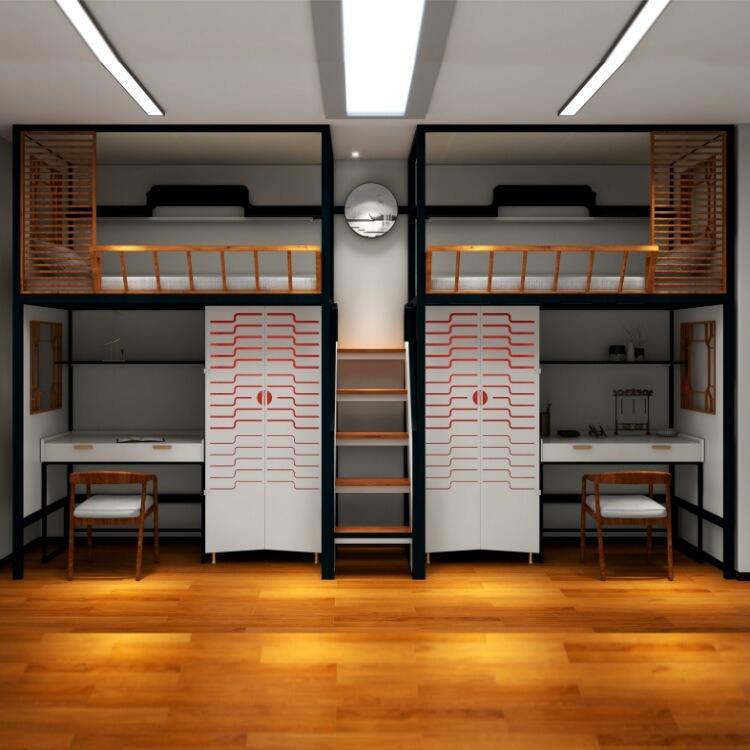Essential Guide to Selecting the Perfect Metal Sleeping Solution
When it comes to maximizing living space while ensuring comfort and durability, a metal bunk bed stands out as an excellent choice for both homes and dormitories. These versatile pieces of furniture have evolved significantly from their basic institutional origins to become stylish, practical solutions for modern living spaces. Whether you're furnishing a children's room, a college dorm, or a guest room, selecting the right metal bunk bed requires careful consideration of various factors to ensure you make the best investment for your specific needs.
Today's market offers an impressive array of metal bunk bed designs, from traditional twin-over-twin configurations to more sophisticated layouts featuring workspaces and storage solutions. Understanding the key aspects of these sleeping solutions will help you make an informed decision that balances functionality, safety, and style while maximizing your available space.
Design and Configuration Options
Classic Bunk Layouts
The most traditional metal bunk bed configuration is the twin-over-twin setup, which features two identical mattress spaces stacked vertically. This design is perfect for children's rooms or shared spaces where maximizing floor area is essential. For rooms with higher ceilings, you might consider triple bunks, which can accommodate three sleepers while maintaining a relatively small footprint.
Another popular variation is the twin-over-full design, offering a larger sleeping area on the bottom bunk. This configuration is ideal for families with children of different ages or when adults occasionally need to use the lower bunk. The extra space on the bottom provides more comfort without significantly increasing the overall footprint of the unit.
Specialized Configurations
Modern metal bunk bed designs often incorporate additional features to enhance functionality. L-shaped configurations create a corner workspace beneath the top bunk, perfect for students or home offices. Some models include built-in desks, shelving units, or storage drawers, making them excellent space-saving solutions for smaller rooms.
Futon bunk beds combine sleeping and seating areas by featuring a convertible sofa on the bottom level. This versatility is particularly valuable in studio apartments or multipurpose rooms where furniture needs to serve multiple functions throughout the day.
Material Quality and Construction
Metal Types and Finishes
The durability of a metal bunk bed largely depends on the type of metal used in its construction. Steel is the most common material, offering excellent strength and longevity. Look for powder-coated finishes that resist scratches and chips while preventing rust formation. Some premium models feature aluminum components, which provide additional corrosion resistance while keeping the overall weight manageable.
The thickness of the metal tubing also plays a crucial role in the bed's stability and durability. Higher gauge numbers indicate thinner metal, so opt for lower gauge numbers (typically 12-16 gauge) for superior strength and longevity. Quality welds and reinforced connection points ensure the structure remains stable even with regular use.
Safety Features
Safety should be a top priority when selecting a metal bunk bed. Look for models with full-length guardrails on the top bunk and secure ladder attachments. The guardrails should extend at least five inches above the mattress surface to prevent accidental falls during sleep. Integration points between components should be smooth and free from sharp edges or protruding hardware.
Check that the ladder design provides secure footing and comfortable hand grips. Some models offer angled ladders or built-in steps, which can be easier and safer to navigate than traditional vertical ladders, especially for younger children or elderly users.
Space Considerations and Room Planning
Dimensional Requirements
Before selecting a metal bunk bed, carefully measure your available space, including ceiling height. Standard bunk beds typically require a minimum ceiling height of 8 feet to ensure adequate headroom for the top bunk occupant. Remember to account for additional clearance needed for making beds and changing linens.
Consider the bed's footprint in relation to other furniture and traffic patterns within the room. Allow at least two feet of clearance around the bed for safe access and comfortable movement. If the room has sloped ceilings or architectural features like windows or air vents, factor these into your placement decisions.
Room Layout Optimization
Strategic placement of your metal bunk bed can enhance the overall functionality of the room. Position the unit against a solid wall for stability, and consider how natural light sources will affect both bunks. If the room serves multiple purposes, plan the layout to create distinct zones for sleeping, studying, and storage.
Take advantage of vertical space by incorporating storage solutions that complement the bunk bed. Wall-mounted shelves, hanging organizers, and under-bed storage containers can help maintain an organized environment while maximizing the space-saving benefits of your bunk bed configuration.
Assembly and Maintenance Considerations
Installation Requirements
While metal bunk beds generally offer straightforward assembly, proper installation is crucial for safety and longevity. Ensure all necessary tools and hardware are included with your purchase, and carefully follow the manufacturer's assembly instructions. Most metal bunk bed designs feature modular components that bolt together, making initial assembly and future disassembly more manageable.
Consider whether you'll need professional assistance for assembly, particularly for heavier or more complex configurations. Some retailers offer installation services, which can be worth the additional cost to ensure proper setup and structural integrity.
Long-term Care
Regular maintenance helps preserve the appearance and structural integrity of your metal bunk bed. Periodically check and tighten all bolts and connection points, as normal use can cause fasteners to loosen over time. Clean the metal surfaces regularly with appropriate cleaning products to prevent buildup of dust and maintain the finish.
Inspect the mattress support systems and ladder attachments regularly for signs of wear or damage. Addressing minor issues promptly can prevent more significant problems and extend the life of your bunk bed investment.
Frequently Asked Questions
What is the weight capacity for typical metal bunk beds?
Most standard metal bunk beds can support 200-250 pounds per bunk, though some heavy-duty models can accommodate up to 400 pounds per sleeping surface. Always verify the specific weight limits for both upper and lower bunks, as they may differ.
Are metal bunk beds suitable for adults?
Many metal bunk beds are designed to safely accommodate adults, particularly those with higher weight capacities and full-sized bottom bunks. Look for models with reinforced frames and adequate headroom for comfortable adult use.
How long do metal bunk beds typically last?
With proper maintenance and care, a quality metal bunk bed can last 10-15 years or more. The durability largely depends on the construction quality, usage patterns, and regular maintenance routine.


